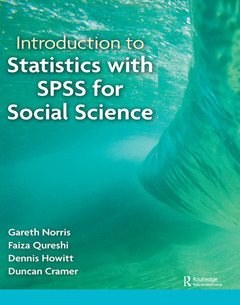Description
Introduction to Statistics with SPSS for Social Science
Author: Qureshi Faiza
Language: English
Subject for Introduction to Statistics with SPSS for Social Science:
Keywords
SPSS Analysis; analysis; Statistically Signifi Ca Nt; score; Multinomial Logistic Regression; variable; Correlation Coeffi Cient; dependent; Unrelated T-test; signifi; Predictor Variable; cance; Dummy Variables; level; Fi Ve; Log Linear Analysis; hypothesis; Numerical Scores; multinomial; SPSS Output; Standard Error; Binomial Logistic Regression; Score Variable; Related T-test; Pearson Correlation; Sample Means; Null Hypothesis; Wilcoxon Matched Pairs Test; Variance Estimate; Vice Versa; ANOVA Summary Table; Dependent Variable; SPSS Procedure; Partial Correlation
· 19.5x26.4 cm · Hardback
Description
/li>Contents
/li>Biography
/li>
Part One Descriptive Statistics. Chapter 1 Why you need statistics: types of data Chapter2 Describing variables: Tables and diagrams Chapter3 Describing variables numerically: averages, variation and spread Chapter4 Shapes of distributions of scores Chapter 5 - Standard deviation, z-scoresand standard error: the standard unit of measurement in statistics Chapter 6 Relationships between two or more variables: diagrams and tables Chapter 7 Correlation coefficients: Pearson correlation and Spearmans rho Chapter 8 Regression and standard error Part Two: Comparing Two or More Variables and the Analysis of Variance. Chapter 9 - The analysis of a questionnaire/survey project Chapter 10 The related t-test: Comparing two samples of correlated/related scores Chapter 11 the unrelated t-test: comparing two samples of unrelated/uncorrelated scores Chapter 12 Chi-square: Differences between samples of frequency data Part Three: Introduction to Analysis of Variance Chapter 13 Analysis of variance (ANOVA): introduction to one-way unrelated or uncorrelated ANOVA Chapter 14 Two way analysis of variance for unrelated/uncorrelated scores: two studies for the price of one? Chapter 15 Analysis of covariance (ANCOVA): controlling for additional variables Chapter 16 Multivariate analysis of variance (MANOVA)Part Four: More advanced correlational statistics and techniques Chapter 17 - Partial correlation: spurious correlation, third or confounding variables (control variables), suppressor variables Chapter 18 Factor analysis: simplifying complex data Chapter19 Multiple regression and multiple correlation Chapter 20 Multinomial logistic regression: Distinguishing between several differentcategories or groups Chapter 21 - Bionomial logistic regression Chapter 22 - Log-linear methods: The analysis of complex contingency tables




